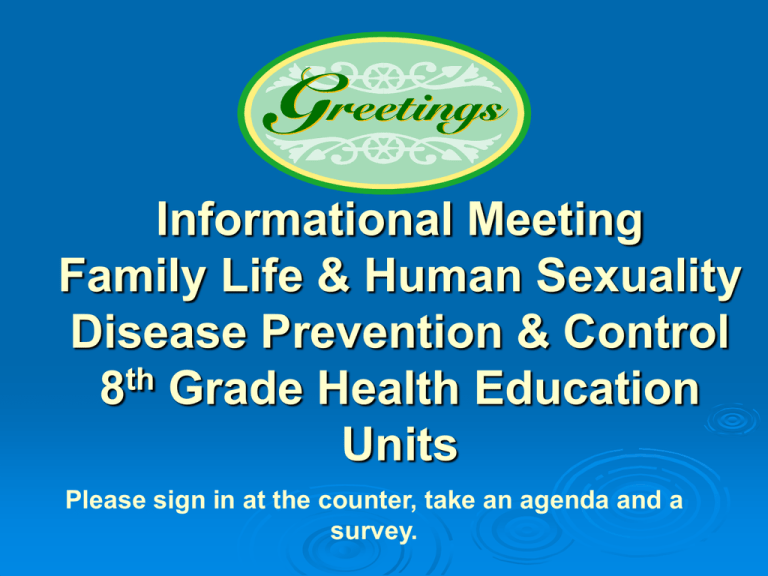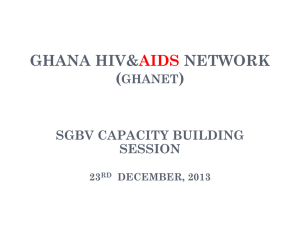
Informational Meeting
Family Life & Human Sexuality
Disease Prevention & Control
8th Grade Health Education
Units
Please sign in at the counter, take an agenda and a
survey.
Hola Padres!
Esta sesion es solamente en Ingles,
Si ustedes necesitan mas
informacion en Espanol, llame Sra.
Jaskolski en la escuela para una
sesion con un interprete.
Meeting Ground Rules
Silence cell phones
and pagers
Listen to understand
Limit sidebar
conversations
Respect Time Limits
Speak one at a time
Health Education Staff
Mrs. Judy Jaskolski - Health Education & Physical
Education Teacher
Mrs.Chanda Guitano-Stephens– Health & Physical
Education Teacher
Mr. Edward Owusu–Principal
Ms. Sweta Zaks– Assistant Principal
Mr. Paul Ajamian – Assistant School Administrator
Parameters for Meeting
This meeting is a time to gather information,
peruse materials and ask questions.
If you need more time or more information please
schedule an appointment to meet with Mrs.
Jaskolski by calling the school.
Curriculum for all focus areas of health education
are set by the county. Curricular changes cannot
be made at the school level.
State of Maryland
Middle School Health Curriculum
Local School Planning Committee
Paul
Ajamian
Paula Ashcraft
Rebecca Ashcraft
Lori Black
Tina Carroll
Chanda Stephens
Judy
Jaskolski
Candice Jones
Edward Owusu
The purpose of this committee was to help plan the
general meeting that you are attending tonight. Many
thanks to these parents, staff and students who donated
their time to make things go smoothly this evening.
They also have reviewed the curriculum and identified
areas of emphasis needed for our school community.
Timeline
•Summer- Teaching staff sends out a call for volunteers for
the School-Community Planning Meeting and publicizes
dates of informational parent meetings
•8 weeks prior to instruction: Teaching staff prepares
materials for the School-Community Planning Meeting
•6 weeks prior to instruction: Hold school-community
planning meeting
•5 weeks prior to instruction: Distribute Parent Notification of
Informational Meetings and Permission Forms
•1 week prior to instruction: arrange for students who are
opted out to report to the media center
Approximate Dates Instruction Begins
FLHS
Jaskolski – current 8th
grade
Guitano-Stephens –
current 8th grade
McLellan – current 8th
grade
Thomas – current 8th
grade
DPC
10/6
10/25
1/3
1/18
3/8
3/24
5/11
5/24
Overview of the Middle School
Health Curriculum:
Family Life and Human Sexuality
Grade 6 – 2 days
Grade 7 – 2 days
Grade 8 – 12 days
Puberty
Family
Healthy
Reproduction
Influences
Family Relationships
Relationships
Sexual behaviors and
decisions
Responsible behaviors
with families
Parenting
Sexual Maturation
Gestation
Pre-Natal Care
Teen Pregnancy
Contraception
Respect for Differences
Overview of the Middle School
Health Curriculum:
Disease Prevention
Grade 6 – 4 days
Grade 7 – 6 days
Grade 8 – 7 days
Disease
Communicable
Prevention
Media
Messages
Sun and Tobacco
Related Illnesses
HIV/AIDS and how it
is transmitted
and
Non-Communicable
Diseases
The Immune System
STD’s/STI’s
HIV/AIDS
Review
STD’s/STI’s
HIV/AIDS – progress
of the disease and
societal impact
Overview of the Middle School
Health Curriculum:
Safety and Injury Prevention
Grade 6 – 6 days
Grade 7 – 8 days
Grade 8 – 3 days
Identify
Apply
Responsible
Emergency
Response
School Safety
Home Safety
Outdoor Safety
Harassment/Bullying
Emergency
Response
Checking an ill or
injured person
Soft Tissue Injuries
Injuries to Muscles,
Bones and Joints
Heat and Cold
Related Emergencies
Sudden Illness
Media/Technology
Harassment
Choices
Sexual Harassment
Review Emergency
Response
Family Life & Human Sexuality Unit
These indicators were sent home in the parent letter.
4.8.A.1. Describe how family members influence the
development of adolescents.
4.8.A.1.a. Describe the relationships that exist within a
family.
4.8.A.2. Identify and describe the components of a healthy
relationship.
4.8.A.2.a. List the components of a healthy relationship.
4.8.A.2.b. Describe how a healthy relationship can be
demonstrated in a variety of situations.
4.8.A.2.c. Examine factors that influence stereotyping and
generalizations about gender.
4.8.A.2.d. Define sexual identity, including sexual
orientation.
Family Life & Human Sexuality Unit (continued)
4.8.A.4. Recognize factors that influence an individual’s
decision concerning sexual behavior.
4.8.A.4.a. List reasons why abstinence from sexual activity is
a healthy, safe, and responsible decision for adolescents.
4.8.A.4.b. Identify ways to maintain abstinence in a
relationship.
4.8.A.4.c. Model skills to resist peer pressure to engage in
sexual activity, including sexual intercourse.
4.8.A.4.d. Examine reasons why people engage in sexual
activity, including sexual intercourse, such as to have
children, desire to have someone to love, to express love, for
enjoyment, curiosity, alcohol/drug influence, partner
pressure, media influence, to gain social status.
Family Life & Human Sexuality Unit (continued)
4.8.A.5. Explain the gestation process of fetal
development and maternal changes.
4.8.A.5.a. Describe the fertilization process.
4.8.A.5.b. Describe the implantation process.
4.8.A.5.c. Describe the stages of gestation.
4.8.A.5.d. Describe the birth process.
4.8.A.6 Explain the principles of prenatal care.
4.8.A.6.a. Distinguish between positive and negative
examples of prenatal care.
4.8.A.6.b. List the components of proper personal
prenatal care.
4.8.A.6.c. List the components of proper professional
prenatal care.
Family Life & Human Sexuality Unit (continued)
4.8.A.7. Explain the impact of teen pregnancy.
4.8.A.7.a. Discuss the impact of unplanned pregnancy on the
teens, their child, and their families.
4.8.A.7.b. List reasons why people get pregnant such as: not
being abstinent, by accident, not using contraception, to keep
a partner, to have a child to love.
4.8.A.7.c. State the impact of teen pregnancy on society.
4.8.A.8. Recognize qualities necessary prior to parenting.
4.8.A.8.a. Identify safe and appropriate living conditions for
children.
4.8.A.8.b. Identify knowledge, skills, and personality traits
necessary for the appropriate care of a child.
Family Life & Human Sexuality Unit (continued)
4.8.A.9. Recognize the responsibilities of parenting.
4.8.A.9.a. Assess the costs associated with raising a child.
4.8.A.9.b. Evaluate the impact of parenting on time
management.
4.8.A.9.c. Identify skills that demonstrate effective parenting.
4.8.A.10. Describe methods of contraception.
4.8.A.10.a. Explain how each method of contraception works
to prevent pregnancy, including effectiveness.
4.8.A.10.b. Explain how each method of contraception is
used.
4.8.A.10.c. List the advantages and disadvantages of each
method of contraception.
4.8.A.10.d. Identify where each method of contraception can
be obtained.
Disease Prevention & Control Unit
7.8.A.1. Describe risk factors and behaviors that influence
contraction and transmission of communicable diseases
or infections.
7.8.A.1.a. Explain how sexual behaviors and practices
influence contraction of HIV/AIDS and STIs
• Abstinence
• Monogamy
• Use of condoms
• Sexual activity, including sexual intercourse
• Multiple partners
Disease Prevention & Contol Unit (continued)
7.8.A.1.b. Explain how other behaviors and practices
influence contraction of HIV/AIDS and STIs.
• Alcohol and drug use
• Sharing needles (piercings, drugs, tattoos)
• Mother to child
• Occupational exposure
7.8.A.3. Recognize and describe symptoms, effects on the
body, treatment, and prevention of HIV/AIDS.
7.8.A.3.a. List specific symptoms of HIV/AIDS.
7.8.A.3.b. Explain the progression from HIV to AIDS.
7.8.A.3.c. Describe the effects of HIV/AIDS on the body,
including the immune system.
7.8.A.3.d. State ways to prevent HIV/AIDS.
7.8.A.3.e. Examine various modes of treatment.
Disease Prevention & Contol Unit (continued)
7.8.A.5 Describe risk factors and behaviors that contribute
to the development of non-communicable diseases.
7.8.A.5.a. Identify risk factors that impact on noncommunicable diseases.
7.8.A.5.b. Categorize the risk factors into controllable or
uncontrollable.
7.8.A.5.c. Identify the protective factors that decrease the
occurrence of non-communicable diseases.
• Regular medical check-ups
• Immunizations and screening
• Diet and weight management
• Exercise and rest
• Environmental exposure
7.8.A.10. Review the causes, symptoms, and prevention of
STIs.
Procedures for the Alternative Units
All students who have opted out of these
instructional units will take the alternative unit.
Students will be given their alternative unit packet
the day before the unit is scheduled to begin
They should take the packets home to share with
parents
They will report to the media center daily during
these units and work on their packet under the
supervision of the media specialist.
They will sign in daily at the media center.
If they have any questions they can see Mrs.
Jaskolski during lunch or after school.
8th Grade Films
Family Life
Disease Prevention
“From Conception to
Birth”
“This Ain’t No Dress
Rehearsal”
“Real People: Teens
Who Choose
Abstinence”
“Reality Matters: Deadly
Desires”
Real People:Teens Who
Choose Abstinence
Real teens discuss the reasons for their
decision to remain abstinent from sexual
intercourse.
The movie uses interviews, group discussions
and classroom presentations to help teens
follow their own values in a world bombarding
them with confusing and contradictory
messages.
This Ain’t No Dress Rehearsal
An emergency room doctor, who also has a private
practice, talks about sexually transmitted diseases.
It also shows individuals who have experienced an
STD. They talk about the emotional and physical toll
that the disease took on their bodies and their lives.
Exposes the real dangers of sexual activity outside
of a single, permanent relationship.
Reality Matters: Deadly Desires
One in three teenagers has had sex by age 16;
two in three by 18. According to researchers, a
quarter of those sexually active teenagers will
contract a sexually transmitted disease (STD).
While most kids know about AIDS and STD's —
and understand how to avoid them — statistics
show that many aren't practicing what's being
preached. This program will explore the reasons
why.
From Conception to Birth
Follows nine couples as they set this exciting
journey in motion, the video explores the
fundamentals of egg and sperm production,
observes cell division within the first few hours of
pregnancy, views gestation at frequent intervals, and
welcomes each child into the world.
State-of-the-art, reality-based animation depicts the
birthing process from the inside out and clearly
conveys the power and complexity of human
development.
A Discovery Channel Production. (51 minutes)
Thank You for Coming!
There will now be a question and answer period If you
have any questions you would like to ask anonymously,
please write them on an index card and put them in the
box.
After the question and answer period you will have some
time to review the 8th grade materials and ask any
additional questions
Finally each of the 4 films will be shown in their entirety
for those wishing to stay. You may also elect to
schedule an appointment with Mrs. Jaskolski to view any
of the films on another day.




